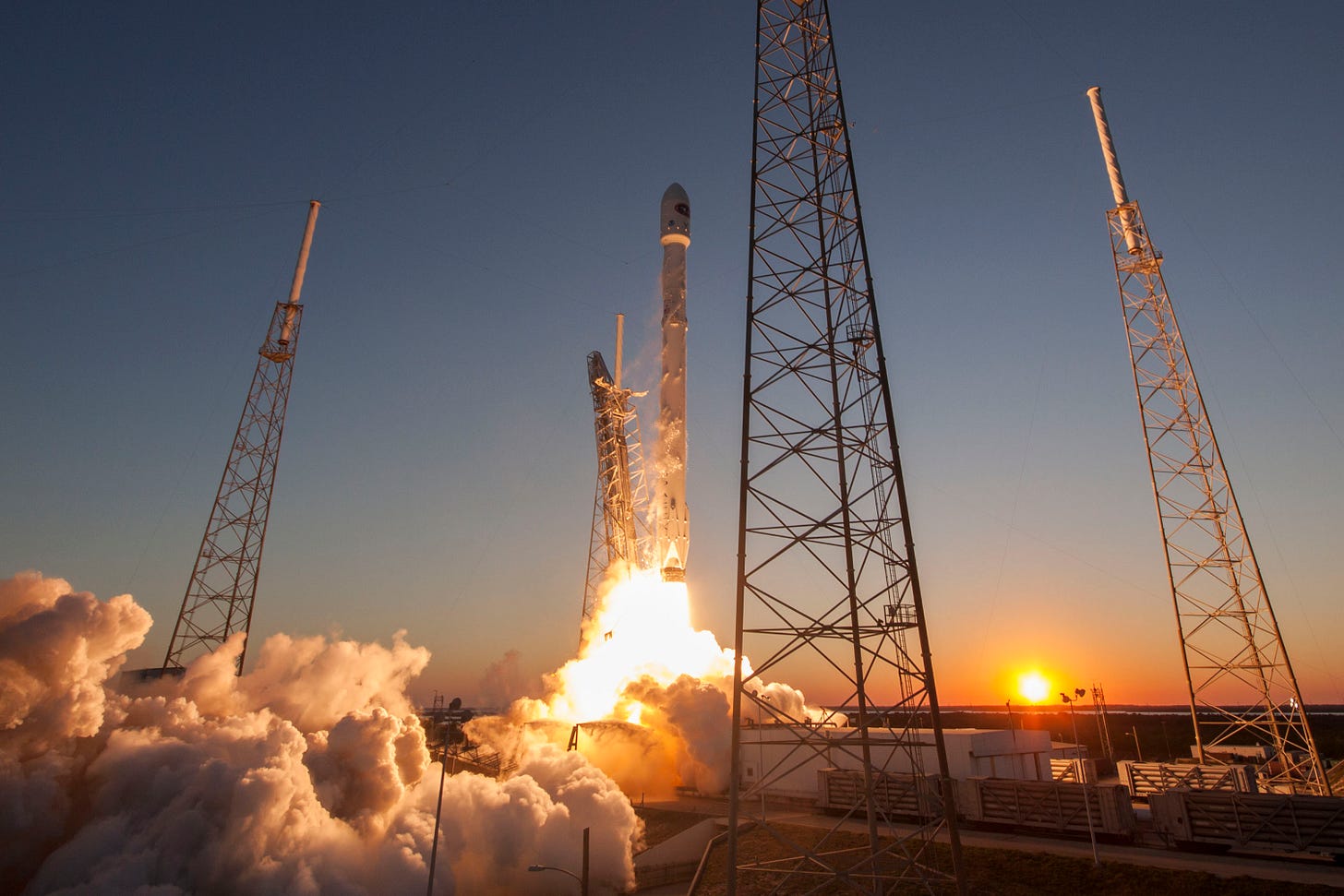Product Study: Falcon 9
Last week I was outside of Vandenberg Air Force Base to watch the launch of SpaceX's Falcon 9 rocket. (It was perfect weather and an amazing experience for my first launch!) To commemorate it, this is another one of a handful of product case studies I wrote to help understand successful product launches.
Falcon 9 was finished in early 2010, and had been in development since 2005. Its first flight occurred on June 4, 2010, a demonstration flight to orbit where it circled Earth over 300 times before reentry.
1st flight to ISS: May 22, 2012
1st cargo resupply (CRS-1): October 7, 2012
1st successful commercial flight: September 29, 2013
Development costs for v1.0 were estimated at $300M. NASA estimated that under traditional cost-plus contracts costs would have been over $3.6B. Total combined costs for F9 and Dragon up to 2014 were ~$850M, $400M of that provided by NASA.
By September 2013, the SpaceX production line was manufacturing 1 F9 every month.
(1) Value created — Simply describe the innovation. How did it create value?
The Falcon 9 is a two-stage rocket that delivers payloads to Earth orbit or beyond. It's a transportation vehicle to space. F9 drastically reduced launch costs, allowing NASA and small satellite companies to send payloads at a fraction of the cost.
(2) Value captured — Competitive advantages, barriers to entry. Why didn't incumbents have a reason to fight them?
Ahead on the learning curve -- highly advanced, experiential, expert knowledge
Capital and time barriers -- lots of money and time needed to get to scale
F9 was a disruptive innovation, built from the ground up at low cost. Incumbent launch companies had no reason to start from scratch and lower their profits when they had strong (mainly cost-plus) contracts with existing customers. Industry was viewed as very inelastic and that little demand existed at low end.
(3) Job-to-be-done — What job(s) does the innovation fulfill?
When I need something in orbit, I want it to be delivered for me, so I can focus on what I'm best at. The only substitutes are other launch services providers.
(4) Technology
Where in the "stack" does it fit in? (Why then?)
Uses existing launch pads leased from NASA (Kennedy) or the Airforce (Vandenberg).
Uses existing launch control and tracking.
Advancements in software (simulations, design, control).
Built on 60+ years of aerospace engineering knowledge.
With incremental advancements in engine tech, software, and materials it was only a matter of time before an upstart rocket company used them to lower launch costs. But without Musk it may have taken another 10+ years to get to the same point.
Any unique technical abilities/insights that enabled it?
Highly specialized knowledge in many engineering disciplines.
General insight to rethink rocket and engine design from ground up without taking existing practices or designs for granted.
Build a "1 size fits all" rocket that can launch many different configurations, rather than expensive, custom launches favored by incumbents. (Having only a single rocket design hugely cut down on manufacturing, support, and launch costs compared to competitors.)
How difficult was it to develop?
Extremely difficult due to complexity and perfection that's required for success.
(5) Design
What major needs does it fulfill? The rocket . . .
Can deliver its payload safely.
Can deliver payloads to LEO or GTO (multiple on same flight if config allows).
Can be transported across the country by truck.
Allows for many different payload configurations.
Can withstand many tests and delays in adverse conditions.
How did design affect product outcome?
Designed to be "one-size-fits-all" -- the ability to adapt the 2nd stage to many different payload configurations -- allows for further reduction of costs.
Designed from the beginning for the 1st stage to be reusable, which had the potential to drastically reduce costs.
(6) Most important metrics
Launch cost per kg of payload
Launches per year
% of successful launches
(7) Distribution
Innovation: What about the innovation made it amenable to distribution?
Relative advantage, in cost, was very high.
Upstart in low competition industry (highly visible).
Compatible with existing satellite configurations -- or just custom-built configs from customers.
Successful launch(s) highly visible.
Communication channels: How did people find out about it?
Press
High value enterprise sales (with only a small list of potential customers)
Delivery (supply chain): How was the innovation physically delivered to users?
Both stages are built in the SpaceX facilities in Hawthorne, CA and driven cross-country to the launch site, then assembled on location in the leased SpaceX launch facilities.
Time: The timeline of distribution.
Development took ~5 years.
Received NASA contract during development.
1st demo flight to ISS took place ~2 years later.
1st commercial flight >1 year later.
The "early adopter" in this case was the government, which acted in part as funding for development.
(8) Management — What personal aspects led to success/failure?
Did any 1 (or more) people play a significant role in outcome?
Elon Musk, CEO
Gwynne Shotwell, COO
What skill sets/talents were needed in development & distribution?
Assembling a team of talented aerospace engineering, mechanical engineering, astronautics, and materials science professionals
Strong project management skills to organize everyone and keep the ball rolling
Experience working with large government contracts
(9) What ultimately were the 1-3 things that made it a success/failure?
Strong vision and leadership from the top, given long timeline and difficulty of project
First principles rethinking of rocket design & assembly



